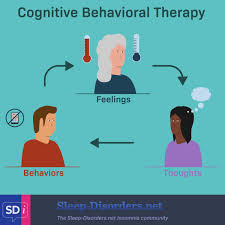The Power of Cognitive Behavioral Therapy for Insomnia
Insomnia is a common sleep disorder that affects millions of people worldwide. It can have a significant impact on daily functioning, mood, and overall quality of life. While medication can be helpful in managing insomnia, Cognitive Behavioral Therapy (CBT) has emerged as an effective non-pharmacological treatment approach.
Understanding CBT for Insomnia
CBT for insomnia is a structured program that helps individuals identify and change the thoughts and behaviors that contribute to their sleep difficulties. It typically involves several components:
- Sleep Hygiene Education: CBT therapists educate patients about healthy sleep habits and lifestyle practices that promote better sleep.
- Cognitive Restructuring: This component focuses on identifying and challenging negative thought patterns and beliefs about sleep that may contribute to insomnia.
- Stimulus Control: Patients learn techniques to associate the bed with sleep rather than wakefulness, helping improve sleep efficiency.
- Sleep Restriction: This technique involves limiting the time spent in bed to increase sleep drive and consolidate sleep.
- Relaxation Training: Techniques such as progressive muscle relaxation or deep breathing exercises help reduce physical tension and anxiety associated with poor sleep.
The Effectiveness of CBT for Insomnia
Research has shown that CBT for insomnia is highly effective in improving sleep quality and duration in individuals with chronic insomnia. Unlike medication, CBT addresses the underlying causes of insomnia and equips individuals with long-term strategies to maintain healthy sleep habits.
Seeking Help for Insomnia
If you are struggling with insomnia, consider consulting a healthcare provider or a qualified therapist trained in CBT for insomnia. By addressing the root causes of your sleep difficulties through CBT, you can take proactive steps towards achieving restful and rejuvenating sleep on a consistent basis.
5 Essential CBT Tips for Overcoming Insomnia and Improving Sleep
- Establish a consistent sleep schedule by going to bed and waking up at the same time every day.
- Create a relaxing bedtime routine to signal your body that it’s time to wind down and prepare for sleep.
- Limit exposure to screens and bright lights before bedtime as they can interfere with your body’s natural sleep-wake cycle.
- Avoid caffeine, heavy meals, and strenuous exercise close to bedtime as they can disrupt your ability to fall asleep.
- Practice relaxation techniques such as deep breathing or meditation to help calm your mind and body before going to bed.
Establish a consistent sleep schedule by going to bed and waking up at the same time every day.
Establishing a consistent sleep schedule is a key tip in Cognitive Behavioral Therapy for insomnia. By going to bed and waking up at the same time every day, you can help regulate your body’s internal clock, known as the circadian rhythm. This routine reinforces your body’s natural sleep-wake cycle, making it easier to fall asleep and wake up feeling refreshed. Consistency in your sleep schedule can improve the quality and duration of your sleep over time, contributing to better overall well-being and daytime functioning.
Create a relaxing bedtime routine to signal your body that it’s time to wind down and prepare for sleep.
Creating a relaxing bedtime routine is a key strategy in Cognitive Behavioral Therapy for insomnia. By establishing calming activities before bed, such as reading a book, taking a warm bath, or practicing gentle yoga, you signal to your body that it’s time to wind down and prepare for sleep. This routine helps promote relaxation and signals to your brain that it’s time to transition from wakefulness to sleep, making it easier to drift off peacefully and improve the quality of your rest.
Limit exposure to screens and bright lights before bedtime as they can interfere with your body’s natural sleep-wake cycle.
Limiting exposure to screens and bright lights before bedtime is a crucial tip when implementing Cognitive Behavioral Therapy (CBT) for insomnia. The blue light emitted by electronic devices can disrupt the body’s natural sleep-wake cycle, making it harder to fall asleep and stay asleep. By reducing screen time and opting for dimmer, warmer lighting in the evening hours, individuals can signal to their bodies that it is time to wind down and prepare for rest. This simple adjustment can significantly improve sleep quality and support the effectiveness of CBT interventions aimed at addressing insomnia symptoms.
Avoid caffeine, heavy meals, and strenuous exercise close to bedtime as they can disrupt your ability to fall asleep.
Avoiding caffeine, heavy meals, and strenuous exercise close to bedtime is a crucial tip when implementing Cognitive Behavioral Therapy for insomnia. These factors can significantly disrupt your ability to fall asleep by stimulating your body and mind when they should be winding down for rest. Caffeine, found in coffee, tea, and certain sodas, is a stimulant that can interfere with the natural sleep-wake cycle. Heavy meals can lead to indigestion and discomfort, making it harder to relax and fall asleep. Strenuous exercise close to bedtime can increase alertness and heart rate, making it challenging to transition into a state of relaxation conducive to sleep. By avoiding these triggers before bedtime, individuals can create an optimal environment for restful and uninterrupted sleep.
Practice relaxation techniques such as deep breathing or meditation to help calm your mind and body before going to bed.
To improve your sleep quality and combat insomnia, incorporating relaxation techniques like deep breathing or meditation into your bedtime routine can be highly beneficial. By engaging in these practices before going to bed, you can effectively calm your mind and body, helping to reduce stress and anxiety that may be hindering your ability to fall asleep. Deep breathing and meditation promote a state of relaxation, making it easier for you to transition into a peaceful and restful slumber. Consider integrating these techniques into your nightly routine to enhance your sleep hygiene and promote a more restorative night’s rest.




